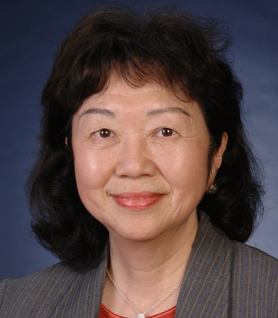- History Home
- People, Leadership & Service
- A Legacy of Excellence
- History & Impact
- Meetings Through the Years
- Resources
Winnie Wong-NgMemoir | Publications | Curriculum Vitae | Videos | Slides | Articles | Obituary ACA Living History
|
|
In her memoir Winnie recalls her odyssey from China and Hong Kong to Baton Rouge, Toronto, Swarthmore, PA and finally to the National Institute of Standards and Technology (NIST) in Gaithersburg, MD, where the broad scope of her research illustrates the wide variety of questions that can be answered by X-ray diffraction. Winnie's honors include being named Fellow of ACA and of ICDD. |
Pre-USA period. When I was a child, I aspired to be a scientist due to the influence of my father, Dr. Wong Shek Hung (黃錫雄), who obtained Chinese government support to study in France and Germany at the end of World War I, in 1919 (during the China 'Diligent Work-Frugal Study Movement'). Among the students who went to study abroad in France at that time were future Chinese leaders Zhou Enlai (周恩來), Deng Xiaoping (邓小平), and others who went on to prominent roles in China. After obtaining his doctorate degree in chemical engineering, my father taught at the Berlin Institute of Science and Technology, and later came back to China and taught at Zhongshan University (中山大学) in Southern China. He subsequently served in a relatively high position in the prewar Chinese government. But he remained uninfluenced by 'power'. He taught his children to be hard-working, kind and generous. After WW II, our family moved to Hong Kong. When I was a child growing up there, my family was quite poor, jobs were difficult to come by, and my father found a job in Thailand. When he died there, I was in the beginning of my junior high school, and we were in a desperate situation. My older sister and brother were in China. My mother never had an opportunity to go to school, so she couldn't work. In her generation it was uncommon for Chinese women to have an education. We couldn't really afford schooling for both my younger brother and me. I overheard some relatives advising my mother that I should work in a factory to support the family. Unlike the US, most schools in Hong Kong were private in those days. I loved schooling and I worked hard to obtain top grades. I remembered crying myself to sleep and praying for the opportunity to continue my education. I worked my hardest to get after-school work and summer jobs, including tutoring young students and various manual jobs, such as assembling mass-produced plastic goods. Later my high school administrator Mrs. Lee (Pooi-To Girls School, 培道中學) gave me a partial scholarship and student work during lunch and after school hours. She also gave me used textbooks and used school uniforms. I was thankful to be able to finish my high school education.
After high school, I passed the Chinese University of Hong Kong entrance examination and received a government scholarship. At the time there were only two formal universities in Hong Kong. It was a tough competition to obtain a slot to study science. With continuing afterschool and summer jobs, I was able to help out my family. I studied chemistry/physics, although my first choice was mathematics. Today as I look back, I am glad that I studied chemistry, which provided me with more opportunities in later years. I also learned that given time, one can learn to love subjects that you were not initially fond of. I had good scientific training at the University, and I am also proud that one of the university professors, Sir Charles K. Kao (高錕), became a Nobel Laureate in Physics in 2009 for his fiber optics communications research.
I was quite ambitious even as a child. I wanted to have as high an education as I could, even though my family could not afford it. It eventually took a number of 'miracles' and sponsorships from friends and a stranger to fulfill my dream. For example, a new club called 'The American University Club of Hong Kong' was formed by US university alumni during my college graduation year, and they wanted to give out travel scholarships to selected students. This was a perfect opportunity for me, as I had been accepted by Louisiana State University, but without financial help. Fortunately I was selected, and along with three other winners, we had our 15 minutes of fame, with interviews on radio, in the newspaper, and on television.
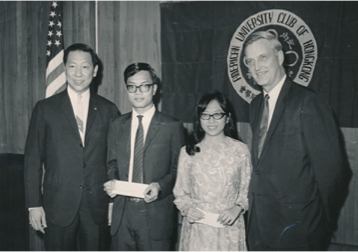
Two winners receiving the scholarship from the American University Club of Hong Kong in 1969.
I was able to borrow money from a classmate's mother (Mrs. Tam) for the first semester's tuition. A total stranger was willing to lend me a large sum of money to deposit in the bank (a prerequisite for visa application to the US). I will never forget my experience at the US Embassy. First of all, according to my fellow students who were in the waiting room for the interviews, I was assigned the most difficult interviewer, who routinely turned down applicants. But I found her to be strict but kind. Even though she knew the bank deposit must have been borrowed, based on my academic record she was willing to let me go. But I had to promise her that I would try to do my utmost best in my studies, and that I must help others whenever I can. I was really touched. At that moment, I believed that God answered my prayers and that 'the stars were all aligned' for me.
Hong Kong to LSU. After I arrived at LSU, I met the graduate school director Professor Clyde Day. I told him I borrowed money for one semester but I knew that with diligence I would be able to find financial help for the next semester. He thought I had great confidence. After taking the PhD qualifying examinations in the next two days, he told me I did extraordinarily well, particularly in inorganic chemistry. He wanted to know what inorganic chemistry textbooks we used at the Chinese University. After I told him the names and authors of the two books we used, he said he was 'stunned' and informed me that he was one of authors, along with Joel Selbin (I had been unaware that he was a well-known chemist and author). I got a teaching assistantship, so I was able to pay back my debt and continued to help my family.
Since high school I have appreciated symmetry and what it brings to the beauty of the world. At first I had no concept of what crystallography is. I first heard of the word crystallography from my 'future' graduate advisor Professor Steve Watkins.
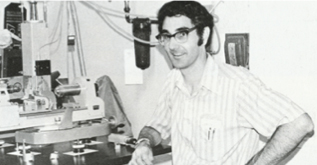
Steve Watkins with a Weissenberg camera at LSU in early 1970s.
I thought it was sort of a crossover discipline between arts and science that needed some mathematics skill. So it seemed to me the best future field to pursue. I was also glad that Professor Watkins introduced me to the beautiful art of the great M.C. Escher. In addition to learning the rudiments of crystallography and experimental skills, I also learned how to apply molecular orbital (MO) calculations to interpret crystal structures, and to understand bonding characteristics and other properties of a compound. The MO technique helped me in later years in a number of projects.
Professor Watkins is an excellent mathematician, adviser, and teacher. In 2002 he received the PAESMEM Award (for outstanding mentorship), presented by President George W Bush. His hard-working discipline also set a great example for his students. We had a fantastic group which became a second family to me.

Watkins' partial group photo in 1974.
We had great fun learning, and playing pranks on each other as we did so. I had a memorable five years, with a teaching assistantship/fellowship that provided the needed support. In 2011 Professor Watkins retired and we had a party for him back at LSU (organized by Frank Fronczek and Julia Chan (2003 Margaret C. Etter Early Career Awardee)). After all these years, we still 'recognized' our fellow LSU graduate students. We visited the well-equipped state-of-the-art X-ray facility. Frank Fronczek (an LSU graduate and a PhD graduate from Cal Tech) has been at LSU for almost 40 years as the departmental crystallographer. We were all impressed by the facility. At the party, most of us gave talks about our ventures in life after LSU. Professor Watkins's own graduate advisor Professor Larry Dahl (University of Wisconsin) was also there.

Professor Watkins' retirement photo (2011) with his former students and coworkers.
L to R: Madeleine Crozat-Williams, Winnie Wong-Ng, Michael Witt, Jerome May,
Larry Dahl, Steve Watkins, Khalil Abboud, Andrea Greene, and Frank Fronczek.
We were indeed very proud that we are the direct academic descendants of Linus Pauling (Watkins → Dahl → Rundle → Pauling).
University of Toronto. After my LSU training, I worked at the Chemistry Department of the University of Toronto, Canada (UT) as a research associate and part-time lecturer. I spent six fruitful years with Professor Stanley Nyburg.
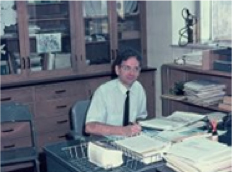
Stan Nyburg in his office (1960s).
I also overlapped with Petros Cheng (later at Mount Sanai Hospital) and I-Nan Hsu (later at UC Northridge). I learned a great deal there. My work included research in areas of theoretical and experimental crystallography.
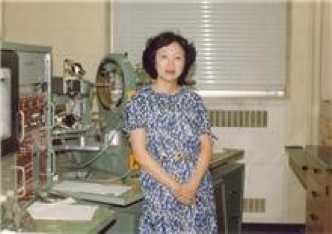
Stan Nyburg's Lab at the University of Toronto (1976).
Two particular projects stood out at UT. By applying the knowledge of MO calculations, we were able to explain the crystal structure of dichlorine by invoking the principle of zero net crystal force. A spherical atom-atom 6:12 potential does not predict the observed Cmca space group, even including point quadrupole interactions. When one uses difference electron density and replaces a spherical atom-atom potential by one that is flattened at the poles, the structure is correctly predicted and it is free from internal crystal forces. Our results reflect the non-spherical nature of the dispersion-repulsion forces in structures that have polarizable atoms (the effective shape of these atoms in the crystal is flattened at the top). This is an important concept for interpreting structures [1].

Shape of the effective atom-atom potential in solid chlorine;
broken line: effective shape of the atoms in the crystal.
Another piece of work that I am proud of is that of the structure solution of a triplet crystal (a monoclinic form sandwiched by two triclinic forms) of a complex natural product (quasi-racemetes of (-) podopetaline and (-)-ormosanine; both crystal forms have 92 independent atoms per unit cell) [2].

Unit cells of the triplet monoclinic and co-crystallizing triclinic polymorphs
of the quasi-racemates of (-)-podopetaline and (-)-ormosanine.
Back in the late 1970s, we had to use the Weissenberg and precession cameras, and a semi-automatic Picker diffractometer to attack this complex problem. (I almost gave up a few times.) From the structure we also found that the triclinic and monoclinic components, while quasi-racemates, like those of many genuine racemates, cannot be resolved by crystallization.
Stan also helped me a great deal in areas outside of science. We encouraged each other to receive our piano training at the Toronto Conservatory of Music. We had much fun. Stan is an excellent player and is at a much higher level than I. I miss his piano playing. My daughter Connie was born when I was at UT. In the baby's first six months, I took her to work, and Stan even helped out baby-sitting. The 'baby' is now a cardiologist teaching at the University of Colorado. Time indeed flies.
After Stan's UT retirement, he still remained active for many years at the Kings College, and University College London. In 2010, to celebrate his 85th birthday, Stan's former graduate students and post-docs (led by Vlad Kochman) gathered at the UT Chemistry Department. The chemistry building has changed quite a bit, with a new wing added on. Some of us met each other for the first time. Our ACA treasurer-elect Sue Byram of Bruker and I studied under Stan at different times.

Stan Nyburg's 85th Birthday reunion at University of Toronto (2010).
We reminisced about our past and had a great time. Stan still looked the same, always with a great sense of humor. During the party, we even talked about possibly working together in the future.
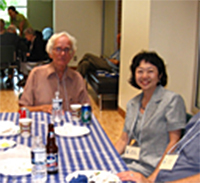
Winnie Wong-Ng reminiscing with Stan Nyburg at his 85th Birthday party (2010).
JCPDS/ICDD. Back in the late 1970s, it was difficult for me to get a faculty job or full-time research position in Canada, so I decided to come back to the States. But without a landed immigrant status (green card) it was rather difficult. Around the end of 1981, I had an opportunity to work for a non-profit organization called Joint Committee on Power Diffraction (JCPDS), which later became the International Centre for Diffraction Data (ICDD), as an X-ray Crystallographer/Critical Review Scientist. It was there that I began my next crystallographic venture, into powder diffraction and database development. ICDD is a scientific organization that holds annual meetings (with about 300 international members from academics, industry and government) and a publishing house. It publishes the Powder Diffraction File (PDF) and other database-derived products for materials characterization.
I spent two years at the JCPDS headquarters in Swarthmore, PA. My two-year contract was to critically review 40,000 diffraction patterns, conduct software development, and create a computerized database [3]. I really enjoyed the challenge, because back then I didn't have experience in powder diffraction. The early 1980s were known to be the time of the 'renaissance of powder diffraction'. The advances in powder diffraction instrumentation and the availability of advanced software for data collection, reduction and determining/refining structures from powder patterns all contributed to the renaissance.
My review/editorial work couldn't have been successful without the editorial program (AIDS*83) that had become available at the time (co-authored by Cam Hubbard, Alan Mighell and Judy Stalick) [4]. This made it possible to modernize the powder diffraction data by converting it from paper form to electronic form, making it possible to derive various computer products. At JCPDS headquarters in those years, I was grateful to Frank McClune (then Editor-in-Chief), Jesse Caum and Julian Messick (general managers) for their guidance. Unfortunately they have all passed away in recent years.
ICDD had an associateship group at the National Bureau of Standards (NBS), in Washington, DC to experimentally prepare high-quality experimental diffraction patterns to be included in the PDF, as phase characterization references. The associateship program was a long-standing (over 35 years), successful industry-government cooperation. After my project was on the way to completion, I requested and received an ICDD associateship at NBS. When I arrived at the beautiful NBS campus in Gaithersburg, MD, I was amazed at the potential opportunities.
Before I became an US citizen in 1988, I couldn't be hired directly by NBS, and I was a research associate through Jim Stewart at the University of Maryland (2001 ACA Fankuchen awardee). Jim's knowledge of computer software was legendary. I remembered that while I was a graduate student, Steve Watkins had mentioned that Jim was one of his heroes, because he had transformed the field of crystallography with his computer skills. As graduate students, we used Jim's computer software suite XRAY for our structure solutions. (We even enjoyed reading the Ozymandias error messages output by XRAY.) So I was very happy to be associated with Jim on our powder diffraction work (Jim passed away a few years ago in PA). I also learned powder diffraction from Cam Hubbard (liaison of the ICDD research associateship with NBS), Howard McMurdie (leader of the ICDD research associateship; we called him Mac), and other NBS Research Associateship colleagues. Both Cam and Mac were amazing mentors and friends. In 1988, Cam was relocated to ORNL and later became the Director of their High Temperature Lab. Mac was at NIST for more than 75 years and he passed away at 991/2 (not before he revealed his secret of longevity: a bar of chocolate, a shot of whiskey/bourbon plus a glass of red wine per day). The associateship had a number of important publications in those days. In addition to various high-quality reference patterns, we also had papers concerning methods for producing reference patterns [5] and how to use standards for diffractometer calibration [6]. The ICDD/NBS Research Associateship Program was successfully concluded in 1986.

In 1986, the mission of the JCPDS/NBS collaboration was accomplished.
The associateship members received a certificate from the NBS Deputy Director Ray Kammer
(Kammer, back row, left; Winnie, front row, right).
Working in powder diffraction helped me understand the applied side of crystallography. Through ICDD I had opportunities to develop contacts and future research collaborators who were from industry, universities, and other government labs. Nowadays it is important to perform collaborative research work and ICDD played an important role in preparing me for my current career.
NBS/NIST. In 1988, I was hired by NBS. President Teddy Roosevelt founded NBS in 1901 with the mission to provide standard weights and measures for international trade purposes, and to serve as the national physical laboratory. In 1988, NBS changed its name to National Institute of Standards and Technology (NIST) to meet the new missions including technology development. NIST invents many things that are important to our everyday life, and it creates and maintains all US primary standards needed to measure just about anything one can think of (length, time, temperature, pressure, volume, electric current, etc.). These standards (more than 1200), called Standard Reference Materials (SRMTM), are important for instrument calibration. In the X-ray area, we have more than 10 SRMs for lattice parameters, d-spacing, intensity, profile measurements, etc. (Cam Hubbard was in charge of the effort before the mid 1980's, followed by Jim Cline after that.)
In the past 27 years, my work at NIST included largely metrology development, and studies in crystallography, crystal chemistry, phase equilibria, and modeling of technologically important materials (microwave dielectrics, ferroelectrics, superconductors, thermoelectric materials, and carbon dioxide capture materials). The techniques that we use include single-crystal X-ray diffraction, and powder X-ray and neutron diffraction. We also use thin film combinatorial methods to conduct high throughput synthesis and characterization for energy conversion materials. I am grateful to the NIST management for their encouragement and support. I have had many talented collaborators from NIST and outside organizations. It was through all these important collaborations that 800 powder diffraction patterns, 50 phase diagrams for technologically important materials, and more than 300 scientific papers have been produced. I will highlight several relevant projects.
Standard Reference Materials (SRM) development for single crystal diffractometers. In order to provide industrial, academic and government laboratories with an SRM for the alignment of single-crystal X-ray diffractometers, an international project was completed around 2000 which involved two major undertakings: (1) an international round-robin (working with ACA) to demonstrate the viability of the selected possible standard, and (2) the certification of a SRM. Both projects were concluded successfully. The SRM1990 is a set of Cr-doped Al2O3 ruby spheres [7]. The certification process used 4 well-aligned diffractometers at Lucent Technologies and at NRC of Canada, confirmed by a Guinier-Hägg camera at the US Geological Survey. These standards are available through the NIST SRM office (http://www.nist.gov/srm).
High temperature superconductors. Our high Tc superconductor project was funded by DOE for more than 15 years. We determined phase equilibria data, multidimensional phase diagrams and crystal structures for three generations of superconductor materials: 1stgeneration, the (Bi,Pb)-Sr-Ca- Cu-O systems; 2nd generation, Ba-R-Cu-O systems (R=lanthanides and yttrium), and 3rd generation, MgB2. Various experimental challenges were successfully dealt with, including atmospheric contamination, substrate reaction, gas-phase interactions, and the complexity of multiphase products [8]. Our results were used to guide materials processing for optimal onset Tc, critical current density, high-field behavior, mechanical properties, and the development of novel flux-pinning techniques. I should mention that one particular piece of work in 1989 involved collaboration with Steve Watkins and Frank Fronczek on the structure determination of a thermomechanically de-twinned superconductor Ba2YCu3O7 crystal at LSU. I caught something on the plane trip to implement the experimental part of the collaboration and became very sick, so Frank had to collect all the data. At the end, we had a very good publication [9]. This is a good place to thank him publicly.
Metrology and data for thermoelectric materials. The continuing demand for environmentally friendly alternative energy conversion technologies has led to greatly increased activity in the area of thermoelectric research. Thermoelectric materials characterization is performed through measurements of the electrical conductivity (σ) , thermal conductivity (k), and the Seebeck coefficient (S). The needs for new, high efficient materials for waste heat conversion and for refrigeration continue. Efficiency of thermoelectric screening can be improved by the use of combinatorial techniques, which we have successfully demonstrated at NIST. We have designed and completed the development of a new set of high throughput tools for screening S , σ, and k of thermoelectric films [10].

We also work on phase diagrams [11] and structure/property relationships of thermoelectric material systems [12]. A low-temperature Seebeck coefficient SRM for instrument calibration has been developed, which fulfilled a major need for the thermoelectric R&D community [13]. Currently we are working on the development of a high temperature Seebeck coefficient SRM.
Carbon mitigation measurements. As coal-burning power plants will be an important part of energy production for the foreseeable future, reduction of CO2 emissions from these plants using efficient and low cost sorbents is critical for global sustainability. Sorbent materials of interest include zeolites, molecular sieves, and metal-organic-framework (MOFs). The main goal of our studies in this area is to develop metrologies and structural data for solid sorbent materials for CO2 capture applications. Crucial factors for understanding the efficiency of porous sorbent materials are the pore structure, and the chemical and physical reactivity of CO2 with the pores. Neutron and X-ray diffraction, small angle X-ray and neutron scattering techniques enable in-situ, real-time measurements of the structure of sorbents, pore interconnectivity and structure, and local adsorbent/CO2 bonding characteristics [14]. NETL and ChemMatCARS/APS are two of our main collaborators.
Environmentally enhanced crack growth. Mechanical failure of brittle materials is a severe problem which limits the use of ceramics in a variety of potential structural applications. The magnitude of this problem increases in the presence of active environmental molecules which enhance crack growth; for example, it has long been recognized that water assists the fracture of silica glass, without a good understanding of the process. We have applied MO calculations to obtain insight into the atomistic and electronic behaviors of water interactions with SiO2. As an H2O molecule approaches the silica crack tip, the distorted initial state of the crack tip (due to strain) reduces steric hindrance to the approach of water, enhances the attraction of the water molecule through increased polarization of the Si-O bond, and reduces the reaction energy barrier [15, 16]. The success of this study has significantly increased our understanding of crack propagation.
My Involvement with ACA and USNC/Cr. I began to be involved with ACA when I was a graduate student, through Steve Watkins. I enjoyed being a member, attending annual meetings, presenting talks, and meeting the 'heroes' of the field. In later years, I became involved by organizing several symposia/sessions and serving on several committees (the Warren Award Committee, Continuing Education Committee, Nominating Committee, and the Data, Standards and Computing Committee).
I had the honor of being the local chair of the 1998 annual meeting (under ACA President Penny Codding) held in the Washington, DC area (Crystal City, VA). We worked with the program chair Louis Delbaere of University of Saskatchewan of Canada. Together with the hard work of the local committee members (Judy Flippen-Anderson, Jeff Deschamps, Charlie Prewitt, Gabrielle Long, Jeff Post, John Barnes, Howard Evans, and others), everything went well - even though we do recall some hair-raising moments. When the meeting hotel (Washington, DC Marriott) pulled out six months prior to the conference due to unforeseen renovation, the committee nearly panicked. But thanks to Judy Flippen-Anderson and ACA treasurer Jane Griffin's ingenious work, not only did we find a nice substitute in Crystal City, but also Marriott compensated ACA financially, which enabled us to have our dinner at the Smithsonian Natural History Museum, as well as providing funding for some other events. During the meeting, we also brought in reporters for a 'meet the press' session to increase our visibility. Together we had a great time organizing and executing the conference. I was very sad that Louis passed away in 2009. I still miss him.
In 2001, NIST celebrated its centennial anniversary. Since NIST has a long history of crystallographic research, a special symposium was co-organized by Alan Mighell and me at the ACA annual meeting in Los Angeles to celebrate this special occasion. Talks included high-pressure, neutron, protein, and synchrotron crystallography, and crystallographic databases. We also co-edited a special issue of the J. Res. Nat'l Institute Stand. Technol., entitled 'Crystallography at NIST' [17].
In 1999, Connie Rajnak introduced me to USNC/Cr, first as a member at-large. From 2000-2003 I served as the treasurer and secretary. The involvement with USNC/Cr really opened my eyes. I learned about a number of important issues and policies, as well as the importance of support of national facilities, and the functional relationships between IUCr, ACA and USNC/Cr. During my tenure, the USNC/Cr Chair, Marvin Hackert of UT Austin (current IUCr president) helped me tremendously so that I could fulfill my job as the secretary. I always look back to those days with fond memories.
My Involvement with other Diffraction and Materials Societies
After I left ICDD as a staff member around 1986, I became a member of the ICDD scientific organization and have since been involved with various activities, including serving as chair of several task groups, of the Ceramic Subcommittee, and of the Membership Committee. In 2010, I was elected as an ICDD/Board of Directors (BOD) member-at-large for four years.
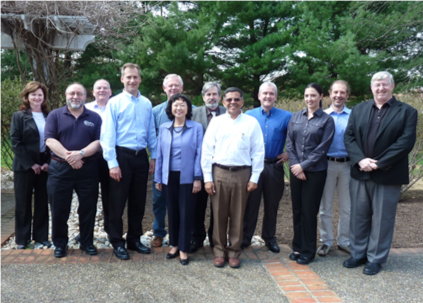
ICDD BOD members (ca. 2013), (L to R: Terry Maguire, John Anzelmo,
David Taylor, Scott Misture, David Balzar, Winnie Wong-Ng, Jordi Rius,
Miguel Delgado, Tom Blanton, Vanessa Peterson, Matteo Leoni, Tim Fawcett).
It was a great experience. The BOD is an important team that works with the Executive Director (currently Tim Fawcett) to manage and guide the organization. We met twice a year, once during the March annual meeting and once in the Fall either at ICDD headquarters or at an appropriate European X-ray conference. We discussed both the business side (financial status, sustainability, scholarship sponsorship, and the grants-in-aid program for generating quality patterns for the PDF) and the scientific side of the organization. We worked diligently to improve the powder diffraction database and its derived products for scientific applications. We also made decisions based on various scientific subcommittees' recommendations. ICDD is also involved in organizing and executing the Denver X-ray Conference. We establish scholarships to support graduate students currently working in crystallographic areas. We discuss how to interact/collaborate with other international organizations. Similar to other scientific organizations, we have to protect and improve our products to benefit the scientific community and maintain the growth of the organization. The job as an ICDD BOD member is always challenging but rewarding.
I have been a member of the American Ceramic Society (ACerS) and the Materials Research Society (MRS), both since 1986. Today ACerS comprises more than 7500 members from 80 countries, with a focus on scientific research, emerging technologies and applications in which ceramic materials are the focus. It is divided into 10 divisions. I am a member of the Electronics Division and the Basic Science Division. I became the chair of the Electronics Division in 2006, and have served as a member of the Nominating Committee and Publication Committee, and as an associate editor for Journal of American Ceramic Society. MRS was founded in 1973 and consists of over 16,000 members from about 80 different countries, and it is one of the largest materials societies. I have organized a number of conferences and workshops throughout the years which had to do with diffraction science and high Tcsuperconductors. The annual meetings of both Material Science and Technology (MS&T, of which ACerS is a member) and MRS often have a strong component involving diffraction science. These might be possible venues for ACA to co-organize special symposia.
Afterthoughts. Throughout my career, I have had plenty of opportunities to work in diverse laboratories (industry, university, and government, from basic science to applications). I have worked on crosscutting disciplines involving materials science, chemistry and physics, with materials in different forms (single crystals, powder, bulk materials and thin films). These opportunities gave me different perspectives as a scientist. I was fortunate to work with many talented collaborators and post-docs/students to develop models, to understand the relationships of fundamental structure and properties and to develop standard reference materials and reference data. All these years, I did notice that regardless of what material areas I worked on, crystallography has always been at the center of my scientific activities, playing a pivotal role. It has always been the foundation for the understanding of new fields. I believe that we, as crystallographers, are the lucky ones that hold an important position in science. We are the link within different branches of solid-state sciences. Our association, ACA, therefore is and will always be a key link to other scientific organizations.
References:
[1] Proc. Royal Soc. London Ser A 367, 29 (1979); [2] Acta Cryst. B 40, 151 (1984); [3] Adv. X-Ray Anal. 26, 87 1982); [4] NBS Technical Note 1141 (1981); [5] Powder Diffr. 1 (1), 40 (1986); [6] Powder Diffr. 2 (4), 242 (1987); [7] J. Res. Nat'l Instit. Stand. Technol., 106 (6), 1071, (2002); [8] Physica C, 377 107 (2002); [9] Phys. Rev. B 41, 4220 (1990); [10] Appl. Phys. Lett. 91, 132102, (2007) ; [11] Solid State Sciences, 48, 1-8 (2015); [12] Chem. Mater., 23, 1491 (2011); [13] J. Mater. Res. 26 (15), 1983 (2011); [14] Cryst. Eng. Comm., 15, 4684 (2013); [15] J. Am. Ceram. Soc., 75 (11) 3097 (1992); [16] Fracture Mechanics of Ceramics, Vol. 12, 219, (1996); [17] J. Res. Nat'l Institute Stand. Technol., Crystallography at NIST, 106 (6) (2002).
Acknowledgements
I would like to thank Virginia Pett and Frank Fronczek of ACA for their invitation to write this memoir. The following is a partial list of collaborators who have helped me in my career: NIST (Qing Huang, Alan Mighell, Judy Stalick, Gasper Piermarini, Gabrielle Long, Andrew Allen, Igor Levin, Bob Roth, Josh Martin, Sara Barron, Laura Espinal, Vicky Karen, Terrell Vanderah, Debbie Kaiser, Larry Cook, C.K. Chiang, Craig Brown, Jeff Lynn, Steve Freiman, Marty Green); ICDD (Frank McClune, Ron Jenkins, Tim Fawcett, Tom Blanton); LSU (Steve Watkins, Frank Fronczek, Clyde Day, Johnnie Marie Whitfield, Madeleine Crozat, Mike Witt); U Toronto (Stan Nyburg, Petros Cheng); ORNL (Cam Hubbard, Claudia Rawn, Amit Goyal, M. Parans Paranthaman, Ron Feenstra); LANL (Quan-Xi Jia, Terry Holesinger); ChemMatCARS/APS (Yu-Sheng Chen, Brian Toby); IIT (Jim Kaduk); University of Missouri (Wai-Yim Ching); UT Dallas (Julia Chan); Lucent Tech. (Theo Siegrist); UpJohn (Connie Rajnak); Honda (Makoto Otani);Wuhan U (Yonggao Yan); NETL (Jeff Culp, Chris Matranga); NRL (Judy Flippen-Anderson, Jeff Deschamps); AFRL (Evan Thomas, Tim Haugan); China U of Geosciences (Guangyao Liu); Yunnan Normal University (Zhi Yang); Columbia University (Siu-Wai Chan).

